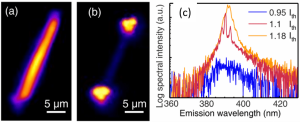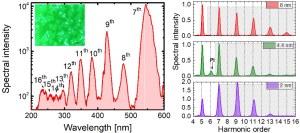Dr. Daniil Kartashov
Image: PrivateDr. Daniil KARTASHOV
Email: daniil.kartashov@uni-jena.de
Phone: +49 3641-9-47235
Dr. Daniil Kartashov holds a senior researcher and teaching position at the Institute for Optics and Quantum Electronics at the Friedrich Schiller University Jena. He is a Principal Investigator in the DFG Collaborative Research Center (CRC) 1375 “Nonlinear Optics down to Atomic Scale (NOA)” and leads the research group on Strong Field Nanophotonics.
Research Areas
Dr. Daniil Kartashov’s research areas include ultrafast nonlinear
optics and spectroscopy, nonlinear nanophotonics, nonlinear dynamics of ultrashort intense laser pulses in transparent
media, strong field phenomena in gases and solids, relativistic plasma physics. His work is currently focused on extreme
optical nonlinearities and high-order harmonic generation
in nanoscale solids.
Teaching Fields
Dr. Kartashov teaches Bachelor‘s and Master‘s degree students in physics and photonics. His teaching activity includes supervision of Bachelor/Master diploma work, lectures and seminars in XUV and x-ray optics, Physics of Optical Discharge and Filamentation. He further contributes to the supervision of internship research student work and physical practicum at the Faculty of Physics and Astronomy.
Research Methods
Dr. Kartashov and his group develop experimental timeresolved ultrafast spectroscopy methods in solids based on highly nonlinear interaction with ultrashort laser pulses. The experimental research is carried out using top level femtosecond laser system, optical parametric amplifier and broad range of spectral and temporal diagnostics including high resolution spectrometers for different spectral ranges, frequency up- and down-conversion methods like FROG, X-FROG etc.
a) Spontaneous and b) lasing emission from a single ZnO nanowire pumped by 3.9 micron intense femtosecond laser pulses. c) The emitted spectrum at different pumping intensities measured relative to the threshold lasing value 0.7 TW/cm2.
Image: Kartashov research group.Recent Research Results
The Strong Field Nanophotonics group works in the very novel research field of nonlinear nanophotonics with special focus on extreme nonlinearities of interaction. When intensity of ultrashort laser pulses approaches the optical breakdown limit of the material, the nonlinear laser-matter interaction proceeds in a new regime beyond standard perturbative nonlinear optics. One of the unique characteristics of this regime of interaction is the significant population transfer of carriers from the valence band to the conduction band in semiconductors mediated by multiphoton absorption or tunneling. As a result, two major effects are experimentally detected and investigated: off-resonance optically pumped population inversion and high-order harmonic generation. Combining new pumping mechanism,
HHG spectrum measured in a single atomic layer semiconductor WS2 (left) and in layers of quantum dots of different diameter (right). The shaded area shows harmonics with energy of quanta above the bandgap.
Picture: Kartashov research group.based on interaction with strong off-resonance optical fields, and the geometry of a nanowire, naturally forming a cavity due to spatial mode confinement and high reflectivity of facets, a single semiconductor nanowire laser was demonstrated (see Fig. 1). It is shown that in this novel strong field pumping regime population inversion and lasing can be achieved with arbitrary pumping wavelength ranging from 0.8 micron (near-IR) to 4 micron (mid-IR) and switching the pumping mechanism from multiphoton absorption to tunneling. Excitation of electrons to the conduction band enables generation of high-order harmonics (HHG), based on two different mechanisms: nonlinear Bloch oscillations, i.e. nonlinear currents, driven by the laser field, of electrons in the conduction band and holes in the valence band, and interband electronhole recombination, analog of HHG in gases. The group is conducting experimental investigation of this extreme nonlinear optics effect in bulk and nanoscale semiconductors like 2D materials, thin films, quantum dots and nanowires (see Fig. 2) with special focus on ultrafast carrier and lattice dynamics and its dependence on dimensionality.
[1] Hollinger et al., Nano Lett. 19, 3563 (2019).


